With a country as beautiful as Spain, it can be difficult to create a Spanish bucket list of the experiences you must have in this sun-kissed land. However, I’ve tried creating a Spain bucket list for you from my own travel experiences in Spain and also the travel experiences of other travel bloggers who’ve explored this wonderful country.
Be it exploring the famous Spanish cities like Barcelona (which is also my favourite city in Spain), Seville, and Madrid or soaking the relaxed vibes of less-touristy coastal towns and islands, Spain has a lot to offer to travellers. The diversity of Spain can be seen from it’s magical landscape that includes everything – forests, deserts, beaches, and mountains.
Whether you want to hike a mountain, take a day trip to a hidden gem, sip the best wine, traverse a town on a horseback, admire the museums and castles, chill your heels on a beach, or attend a festival, Spain caters to all your whims and fancies. And that’s what makes it one of the best travel destinations in Europe.
Spanish Bucket List
In this blog, you’ll find all the best experiences in Spain that you need to include in your Spain bucket list. I’m sure it’ll help you with your travel planning, irrespective of whether you are travelling to Spain for the first time or have been there already.
Spain is the country where I started my journey as a travel-blogger, so it’s quite special to me. I’ve had memorable experiences in Spain and this Spanish bucket list is a sweet reminder of the things that I have done and the things that are still left to do in this gem of a country.
So what are we waiting for? Let’s check out all the amazing Spanish bucket list experiences that you can include in your Spain itinerary!
28 Experiences In Spain To Include In Your Spanish Bucket List
Take a Dip In The Montanejos Hot Springs In Valencia
If you’re looking for an off the beaten path and unique experience in Spain, then check out the Montanejos hot springs. Located about 90 kilometres north of Valencia, the hot springs are a perfect getaway in the lap of nature.
The mountainous area offers adventurous hikes and stunning hot springs in a gorge of stunning limestone cliffs. Since it’s called Montanejos hot springs, you would assume the water to be hot. But don’t be fooled by this name because, in actuality, the water is pretty warm (25°C mostly).
Of course, the water temperature depends on the time of the year you’re visiting, but just keep your hopes in check and don’t expect water vapour emanating from the spring pools.
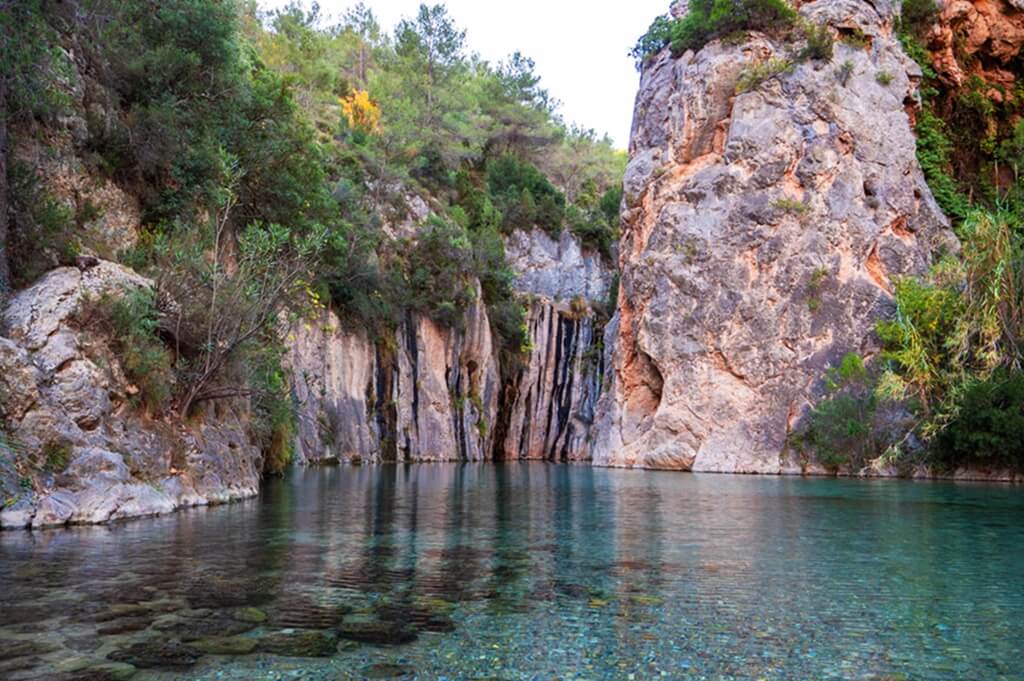
What makes this place a must-include in your Spanish bucket list is the healing nature of the water in the springs. The water has a rejuvenating and positive effect on your skin due to the presence of essential minerals. Also, it deep cleans your skin to give it a smooth, shiny appearance.
The towering limestone rocks and crystal clear turquoise waters are inviting to take a dip in. The hot spring pools are big enough, and that’s a good thing because during the summer period it can get busy with locals and tourists coming here to enjoy their time amidst nature.
To avoid the crowds, go early in the morning or later in the afternoon. The Montanejos Hot Springs are open all day and taking a dip in the spring pools is free of charge.
Best place to stay near Montanejos Hot Springs : Hotel Rosaleda del Mijares.
Contributed by Ilse de Groot from Digital Travel Couple
Explore The Town Of Peniscola
Next on our list of the ultimate Spanish bucket list experiences is exploring the old town of Peniscola. It’s located in the Province Castellon on the Mediterranean Coast.
Due to it’s fabulous location, the fortified city is often called “the city in the sea”. The presence of cute snow-white old town houses also adds to the charm of Peniscola.
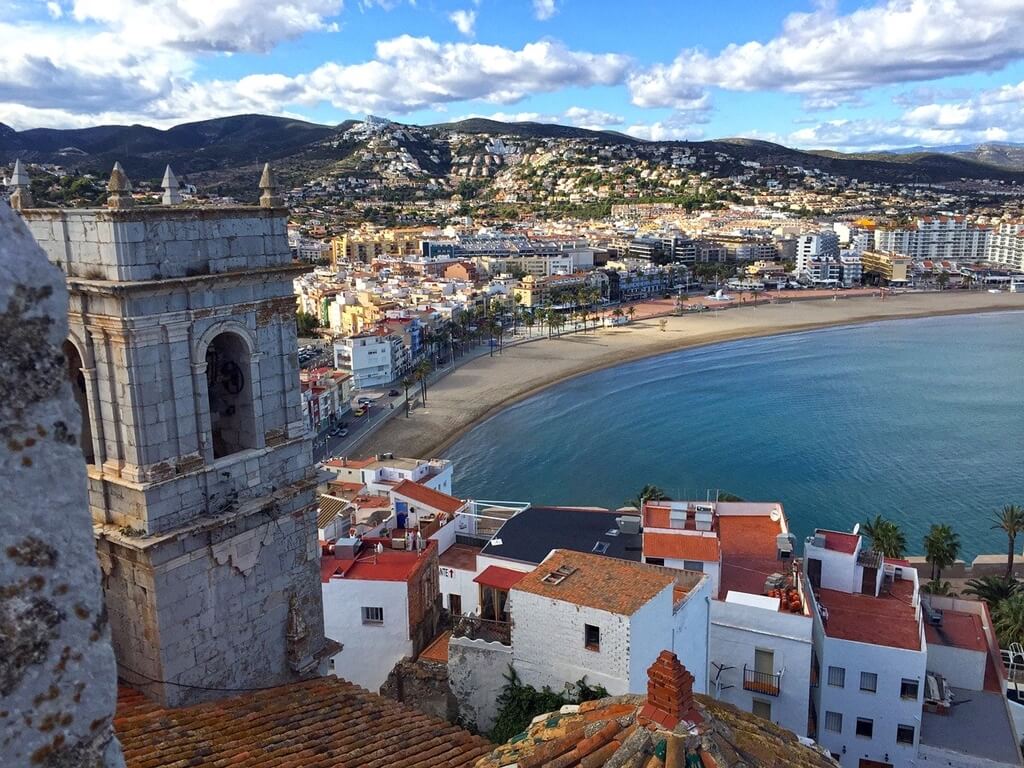
Strolling along Peniscola’s cobbled stone streets with the many lovely shops is one of the most unique experiences in Spain.
The old town is blessed with fantastic beaches, which are just perfect for swimming and sunbathing. The most important attraction here is the Peniscola Castle, which rises 64 metres above the azure blue sea.
Peniscola can easily be reached by a private car or by trains that are connected to Valencia or Barcelona. Good places to stay can be ideally found in the middle of the picturesque white old town.
Best place to stay in Peniscola: Hotel Boutique La Mar.
Contributed by Martina & Jürgen from PlacesofJuma
Take a Paella Cooking Class In Valencia
Paella is one of Spain’s most famous dishes and you can find it in many parts of Spain. But did you know that the paella originated in the region of Valencia? So there is really no better place to take a paella cooking class than in Valencia!
Valencianos take their paella very seriously. They are very strict about which ingredients you can and cannot use, and many still eat it every Sunday.
Taking a cooking class where you learn more about the history of paella and how to prepare this dish, gives you a great insight into the life Spain. And that’s the reason why this activity is worth including in your Spanish bucket list.
The paella cooking class offered by Escuela de Arroces y Paella Valenciana first takes you to a local, very impressive market to buy the ingredients for your paella. Rice, beans, chicken, rabbit, snails, and saffron are the main ingredients of a traditional Valencian paella.
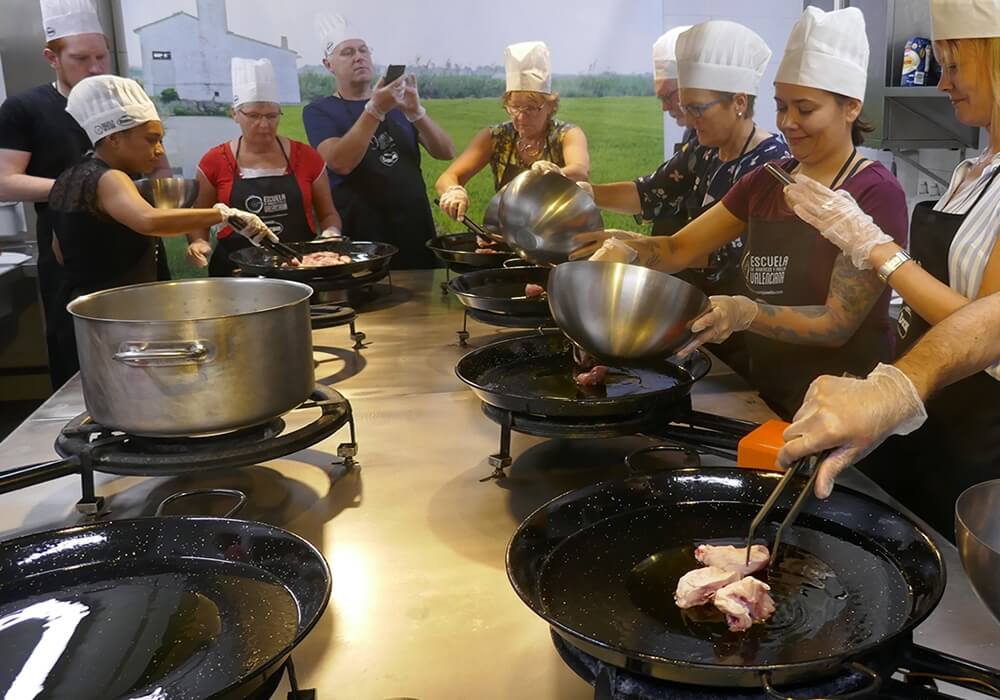
But don’t worry, if the idea of eating rabbit or snails doesn’t appeal to you, you can also choose to cook a seafood paella or a vegetarian paella.
After sourcing all the fresh ingredients and learning a lot about paella and about Valencia, you’ll start cooking your own paella in one of those beautiful, traditional paella pans.
And of course, it all ends with you and your fellow chefs sitting down for a delicious, traditional paella lunch. I can guarantee you that it will be the best paella you will taste in Spain!
If you are travelling to Spain, then visiting Valencia is absolutely worth it. And this cooking class will be an experience you’ll remember for years. The paella cooking class costs 65 Euros per person which includes coffee, wine, snacks, and a lot of paella!
Best place to stay in Valencia: Hotel Plaza Mercado & Spa.
Contributed by Sanne Wesselman from Spend Life Traveling
Visit Sagrada Familia In Barcelona
The Sagrada Família in Barcelona is one of the most popular tourist attractions in Spain that has to be in your Spanish bucket list. After all, this imposing building is one of the most important landmarks in the city, perhaps even the whole country.
The basilica, located in the middle of Barcelona, is also known as probably the oldest construction site in the world. That’s because it has been under construction for more than a hundred years and is still not completely finished.
Although it has not yet reached it’s final size, it is already one of the world’s most visited buildings. Designed by Spanish architect Antoni Gaudi, the Sagrada Familia mesmerizes you with it’s architectural and engineering brilliance.
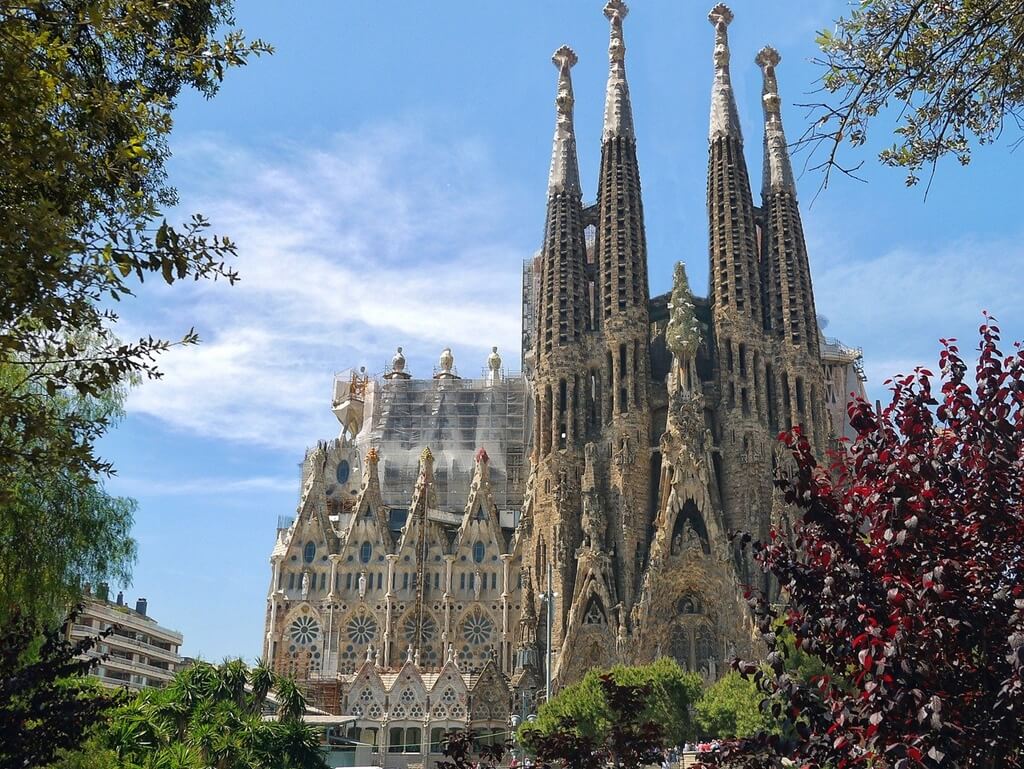
The inside of the basilica can also be visited, depending on the ticket option, for around 20 – 30 €. Through the stained glass windows, the Sagrada Família’s interior is bathed in a breathtaking, colourful light, which offers a truly unique atmosphere.
You can also climb two of the towers to enjoy a splendid view of Barcelona from above. Since it’s the tallest building in the city, no other building will spoil the view.
The Sagrada Família is not far from the center of the city and can, therefore, be easily reached on foot, by bus or by metro.
Best place to stay near Sagrada Família: Hotel Barcelona 1882.
Contributed by Vicki Franz from Vickiviaja
Explore The Pueblos Blancos Of Andalucia
If you’re looking for an exclusive and unconventional Spain bucket list destination, then you must explore the Pueblos Blancos of Andalusia.
The Pueblos Blancos – or White Villages are a fascinating sight; white-washed houses built into the cliff-face of the countryside, teetering on rocky outcrops overlooking stunning valleys.
Officially speaking, there is a collection of 10+ Pueblos Blancos and it is fun to explore them all, observing the similarities and differences between each one.
All of the Pueblos Blancos have their own character and charm, with some featuring Gothic churches and Moorish castles and others being much more rugged and simple.
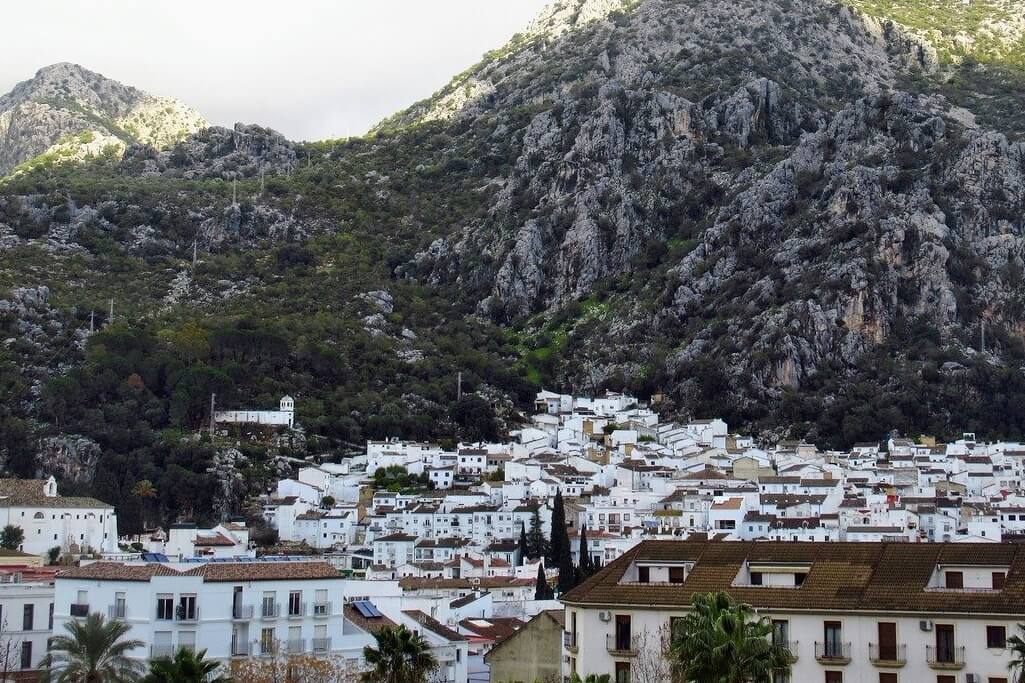
You could easily spend a few days exploring the different towns, either using one as a base or travelling between them and staying in a different place each night.
While visiting the Pueblos Blancos, you could also stop off at the town of Ronda, approximately 30 km away.
This is a town that is famed for it’s epic bridge (the Puente Nuevo) that towers over the valley. If you do decide to rest overnight in Ronda, you should stay at a place that overlooks the gorge.
Best place to stay near Pueblos Blancos (Ronda): Hotel Don Miguel.
Contributed by Chrysoula from Travel Passionate
Experience The Vibe Of Tossa De Mar Town In Costa Brava
The Costa Brava coastline and Tossa de Mar, in particular, is a Spanish bucket list worthy destination. Few people realise that just north of the crowded beaches of Barcelona and just south of the Pyrenees Mountains, there are tons of incredible places and beaches waiting to be discovered.
Tossa de Mar is one of the lesser-known Spanish beach towns. The town’s main beach is known as Great Beach and is perfect for sunbathing and swimming.
The water is clear and deep and if you’d like to explore the ocean further, then there are kayaks for rent and a scuba diving centre nearby as well.
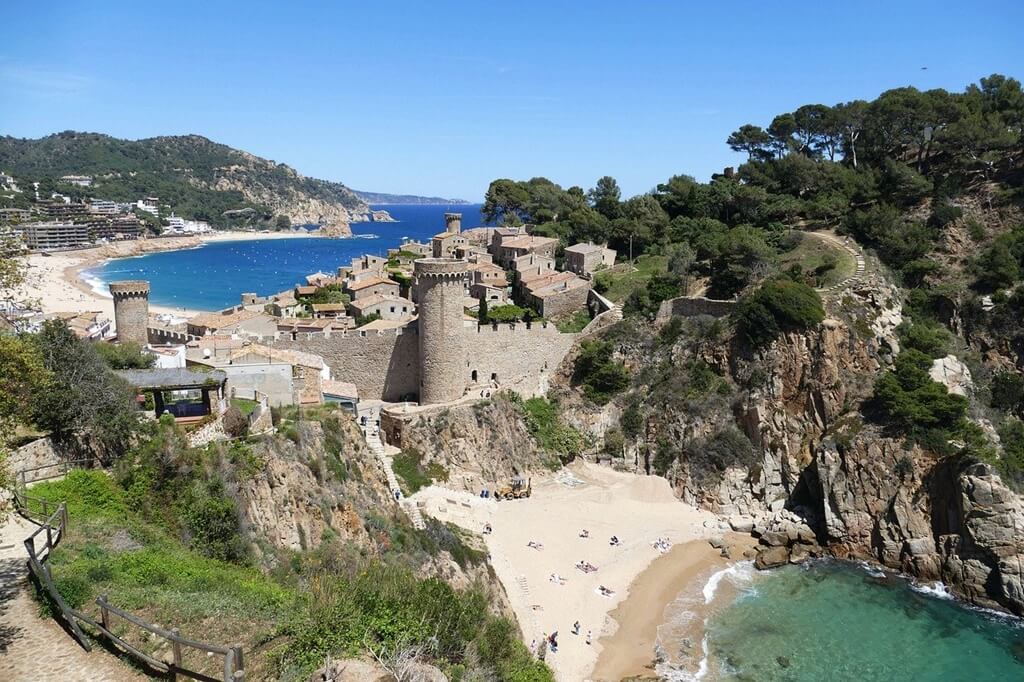
The Fortress at Tossa de Mar looms large over the main beach and is a great place to explore on it’s own. You can walk the walls of the great fortress, the same way soldiers would have in older times.
Enclosed behind the walls of the fortress is the Old City which is known for it’s cobblestone streets and boutique shops and eateries.
Best place to stay in Tossa de Mar: Hotel Windsor.
Contributed by Oksana & Max from Drink Tea & Travel
Attend The La Mercè Festival In Barcelona
Every year when summer ends, the autumn season transitions the gorgeous city of Barcelona, Spain into a festive celebration. This effervescent festival is called La Mercè.
The history of this cultural tradition is to celebrate Verge de la Mercè, which translates to “Virgin of Mercy” in English, a patron saint of Barcelona. Today, this celebration is centered on numerous lively festivities found throughout Barcelona.
La Mercè kicks off with the “Giants parade” – a beautifully coordinated dance parade featuring the former king and queen, saints, and nobles. Other festivities include food trucks stationed at varied locations – Arc de Triomf, or Montjuic Castle.
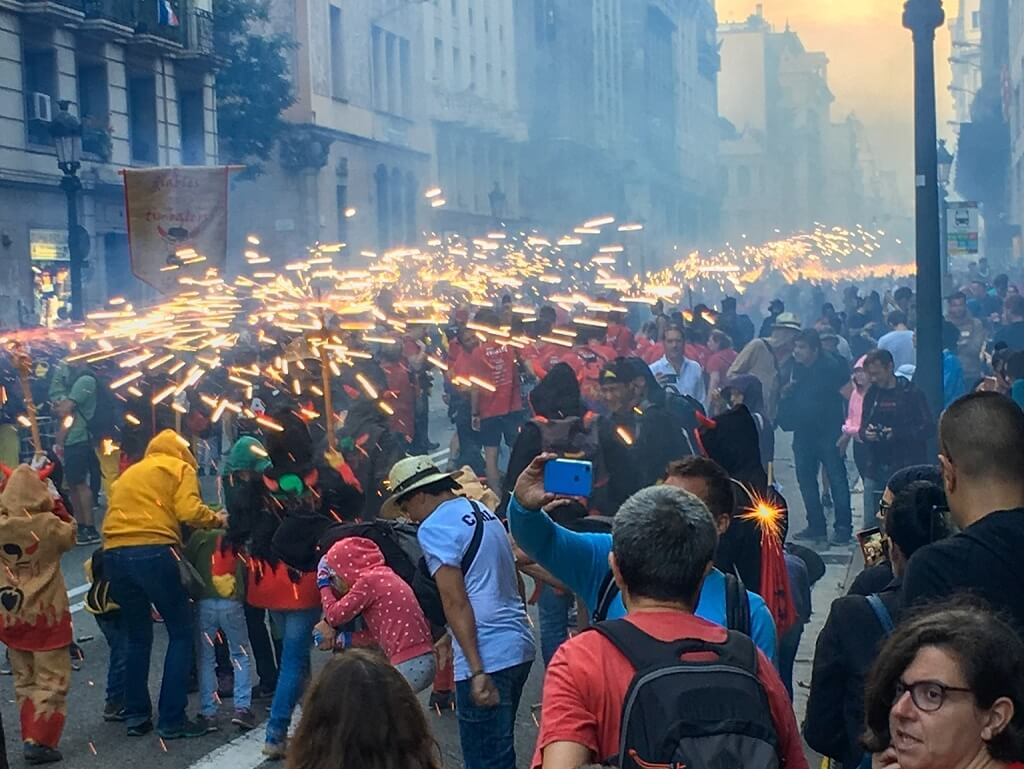
Additional sites have free performances including fascinating circus acts, skilled dance performances, and live music featuring diverse music genres. Just experiencing the local vibrant culture and the positive energetic vibe of the people makes attending this festival a Spanish bucket list activity.
Another thing to do at La Mercè, Barcelona is to watch the correfocs, fire run. The fire run is one of the most invigorating experiences in Spain where you’ll see different groups of people dressed in elaborate costumes skip up the main street with lit firework torches in hand.
Activity guides can be found at Parc de la Ciutadella or online. While most activities are free, do remember to bring cash for the food trucks and Cerveza (beer) gardens.
Best place to stay in Barcelona: Hotel Andante.
Contributed by Ciara Turner-Ewert from Wellness Travel Diaries
Explore The Port City Of Santander
One of the must-see things in Spain that you should put on your Spain bucket list is the beautiful coastal city of Santander. It’s located on the north coast of the country in the Basque region of Spain. There are a lot of things to do in Santander and as you’d imagine, many involve the sea.
Visitors to Santander love the delicious seafood and pinchos. Sardines and rabas are two of the most popular dishes and you can enjoy them at lovely restaurants like Bodega Fuente De.
Another seaside activity is of course, visiting the paradisiacal beaches of Santander. One of the best is Sardinero Beach which is also a popular surfing destination.
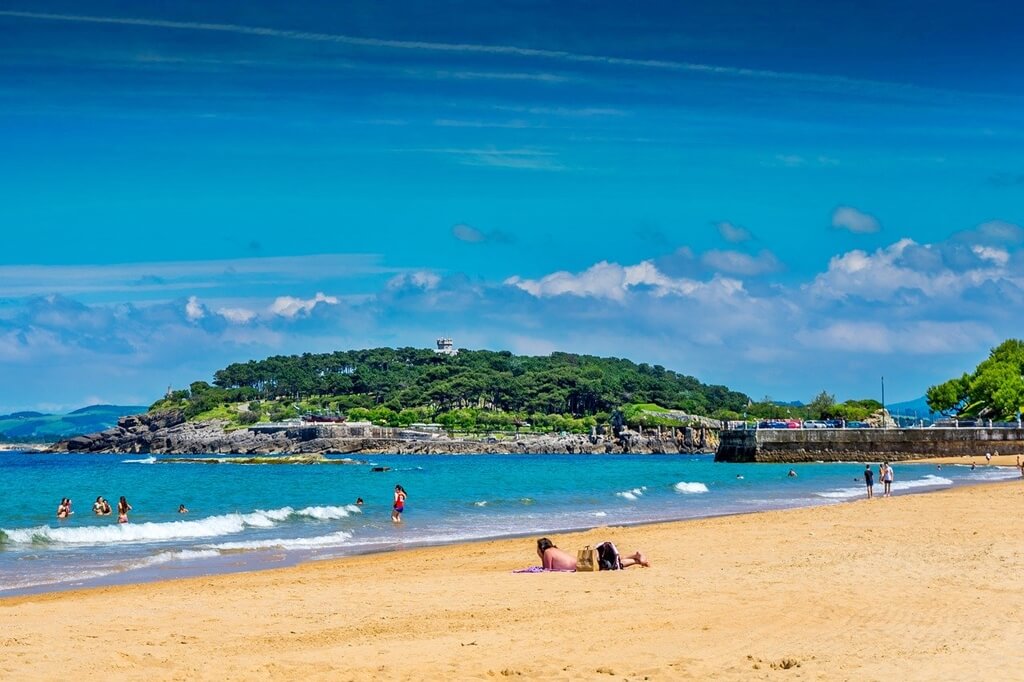
The city of Santander also offers some picturesque coastal walkways that are great for an evening stroll. One of the coastal promenades will take you to Cabo Mayor, a gorgeous lighthouse where you can stop to watch the powerful waves crash below.
Along the coast you’ll also discover Magdelena Palace, the former home of the ‘Royal family’. It’s one of the most visited attractions in Santander and the grounds are perfect for a picnic or photos in the gardens.
Best place to stay in Santander: Hotel Santemar.
Contributed by Derek Hartman from Robe Trotting
Eat Espetos In Malaga
You cannot visit Spain and not get a taste of their delicious local cuisine. If you are a foodie and visiting Malaga, then eating espetos in Malaga has to feature in your Spanish bucket list.
Situated in southeast Spain, Malaga is a seaside city and the birthplace of Pablo Picasso. You can directly get to the city by a high-speed AVE train from Madrid in 3 hours.
Malaga is best known for its typical Andalusian food, particularly the Jamon Serrano which is a mouthwatering, sweet, and salty air-cured ham. The star dish, however, is the Espetos de Sardinas (Sardine Skewers).
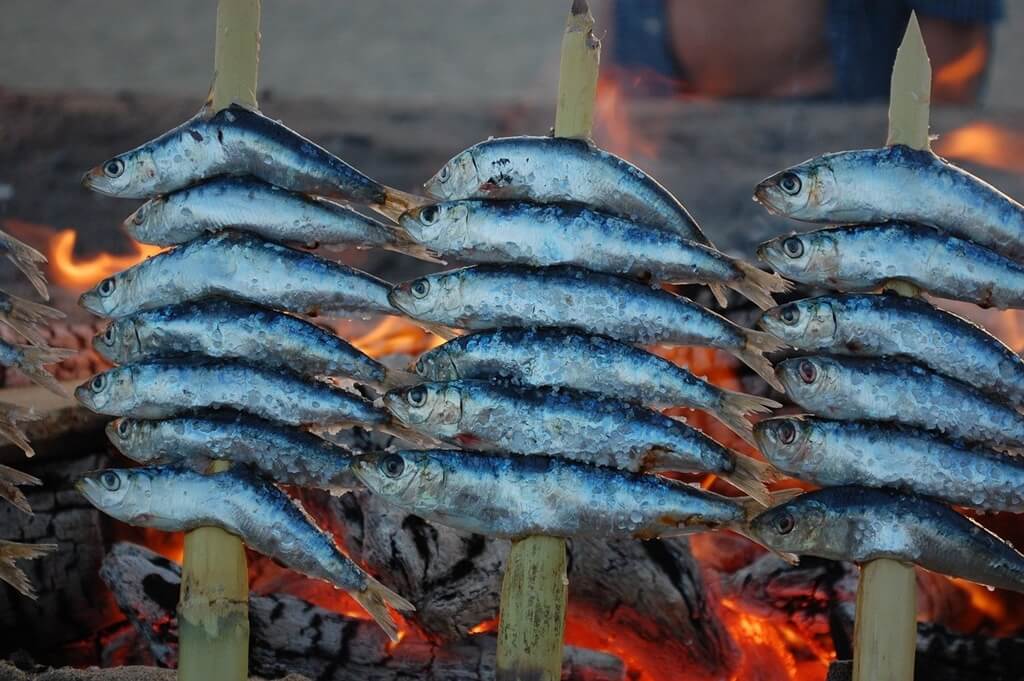
Today, Malaga sardine skewers have become a sign of cultural identity. In fact, they are also the symbol of the town: a sign recognized in the monument to the espetero that is in the Antonio Machado Promenade, next to the Beach of the Misericordia, in Malaga.
Eating espetos in Malaga is definitely a must-do since you can have espetos nowhere else than in the capital of Costa del Sol.
Best place to stay in Malaga: Hotel Gran Miramar.
Contributed by Paulina from Paulina on the road
Hike The Picos De Europa National Park In Asturias
Spain is an amazing country with many incredible places to visit. The Picos de Europa National Park is one of them. It’s name means “Europe’s peaks” and refers to the several mountain peaks between 2000 m and 2600 m located inside the park.
Established in 1918, it was the first national park in the country. The park is situated in the green mountainous range in the north of Spain. If you’re a traveller with an adventurous streak, then the Picos de Europa has to be in your Spain bucket list as it’s an absolute paradise for outdoor and hiking lovers.
There are many walking trails that take hikers through the unspoiled lush green mountains to the most spectacular look-out points, crystal-clear lakes, and beautiful waterfalls.
The Cares route is one of the most famous trails in the park. It’s a 12 km route that starts in Poncebos in Asturias and finishes in Caín in León.
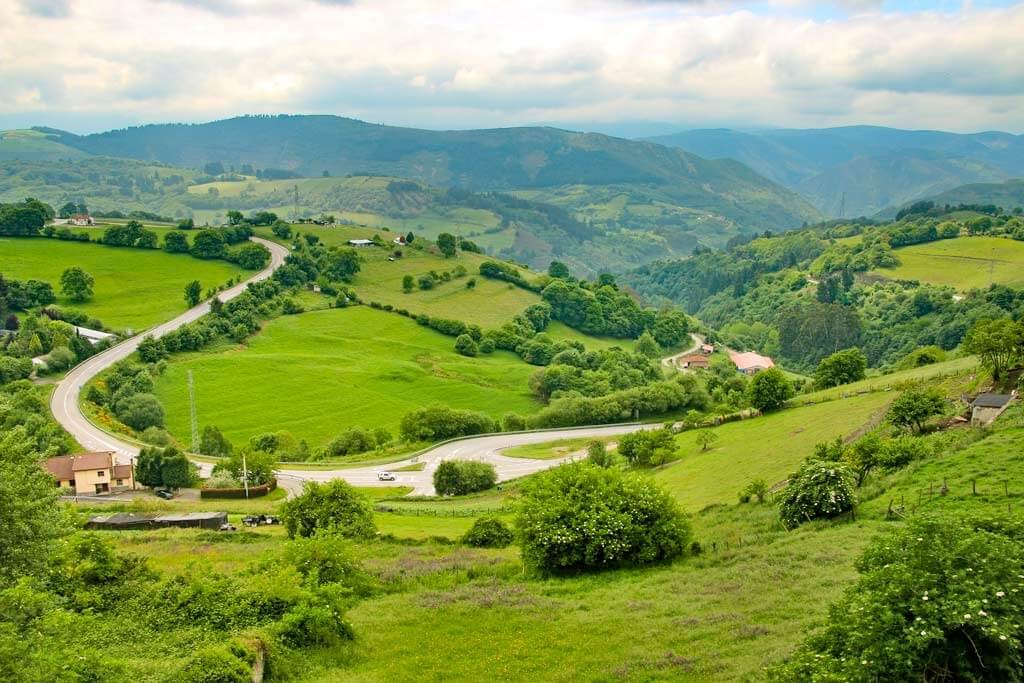
The Covadonga Lakes hike is another spectacular route that is considered to be one of the most scenic trails in the Picos de Europa.
There are several pristine lakes and a couple of breathtaking look-out points along the trail. The trail is quite long, 12 km to the first lake, from there you can continue walking or turn round and head back.
There are several towns around the park where tourists can stay. Llanes, a small coastal town 60 km from the park entrance, is one of the most popular places to stay in the area and has many hostels, hotels, and restaurants.
The summer period between June-August is the best time for hiking in the Picos de Europa.
Best place to stay near Picos de Europa National Park: Hotel El Cantil.
Contributed by Campbell & Alya from Stingy Nomads
Take a Day Trip To The Cies Islands
Taking a day trip to the Cies Islands is a must-have on any Spain bucket list. This tiny archipelago, which is located near the Galician coast, is one of the most beautiful places to visit in northern Spain.
It consists of three islands – Monteagudo, Do Faro, and San Martiño. Out of these, the last two are easily reachable by ferry from either Vigo, Baiona, or Cangas.
What makes this place such a great day trip destination is that here, one gets to enjoy the best of both worlds. On one hand, there are plenty of scenic hikes, some of which are also suitable for non-hikers. On the other hand, the beaches on the island are some of the dreamiest in Spain.
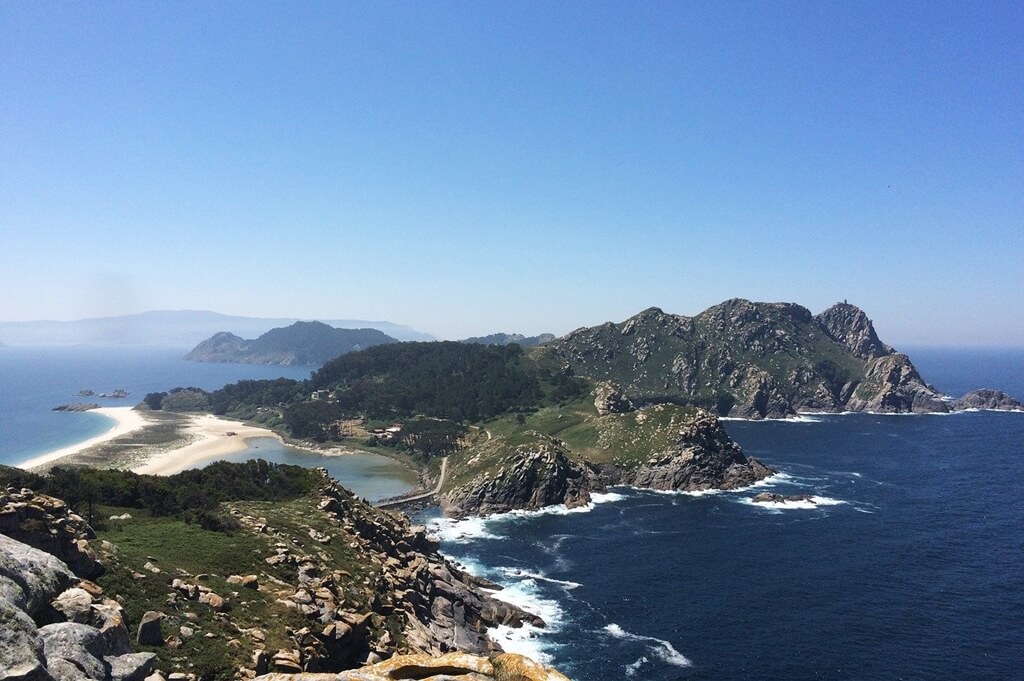
Since the islands are declared a Nature Reserve and a protected area, the only services provided are a visitor center, a restaurant, and a campsite (in which you have to reserve your spot in advance if you wish to rent a tent there). There aren’t any showers or even trash bins, so that’s something to take under consideration.
To get to the Cies Islands, it is a must to purchase the ferry ticket in advance on the website of transport companies like Mar de Ons and Cruceros Rias Baixas (in the process, one also gets the authorization to visit the islands since daily visits are limited).
Best and only place to stay in Cies Islands: Campsite.
Contributed by Or from My Path in the World
Hike To The Top Of Mount Teide In Canary Islands
Hiking gurus often overlook the Canary Islands as they are majorly popular for their beaches and entertainment parks. However, these islands offer many exciting and picturesque trails to hike on and one of the most famous trails is the trail to the top of Mount Teide.
The Teide peak sits atop of Mount Teide in Tenerife island and is almost 4000 metres high, which makes it not only the highest point in Spain but also the highest peak in the Atlantic Ocean. Therefore, a hike to the top of Mount Teide has to be in your Spanish bucket list.
Many think that hiking to the top of Mount Teide is hard, but it can be pretty easy.
There is a cable car at La Rambleta Cable Car Station that you can use, but you need a special permit to access the top of the mountain. It is recommended to request it upfront from here. The price for the cable car is €13.50 for a one-way ticket and €27.00 for a two-way ticket.
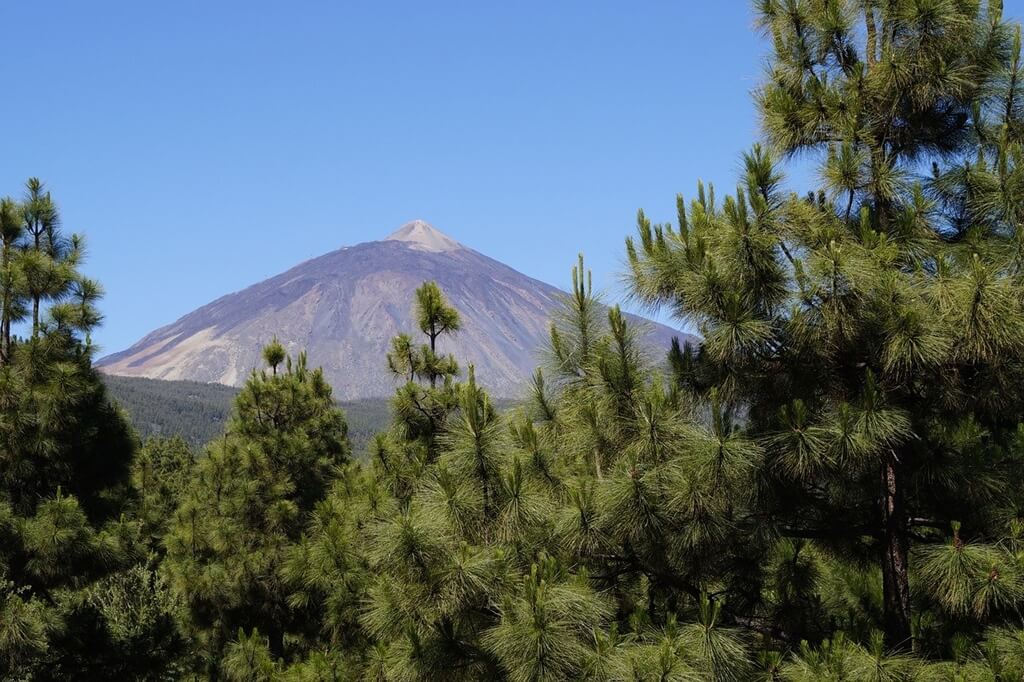
The other way to reach the top of Mount Teide is to hike to it. Hiking to the top is not so hard, as many would think, but it requires you to be very cautious and well-prepared. The hike to the top requires special permission and a good knowledge of the map with routes to the top.
While hiking, it is recommended to stop frequently to get your breath back and get used to the elevation. Also, carry plenty of water and food with you as there isn’t any café or shop around. Dressing properly for this occasion is also recommended – good quality hiking shoes are a must.
Once at the top of Mount Teide, you will be stunned by the beautiful vista that will be revealed before you. The Atlantic Ocean surrounding the island from all sides is a sight to behold.
If you’re lucky, then you might get to see the rest of the Canary Islands from the top, and who knows, you might even get to touch the clouds!
Best place to stay near Mount Teide: Altaviste Refuge.
Contributed by Alex from EarthOSea’s World
Taste Chocolate With Churros In Madrid
First time travellers to Spain have to experience “Chocolate y churros”, a typical treat across the country and a real Spanish bucket list experience.
“Chocolate y churros” is actually Spanish hot chocolate served with churros, a long sausage-shaped doughnut, freshly fried and dipped into the hot chocolate, which is so thick and gloopy that you cannot actually drink it, even though it’s served in a cup!
In the north of Spain, this is a typical everyday breakfast. In fact, along the Camino De Santiago, at popular overnight stops, you’ll find ‘Chocolate y churros’ vans by the side of the road serving the hungry pilgrims.
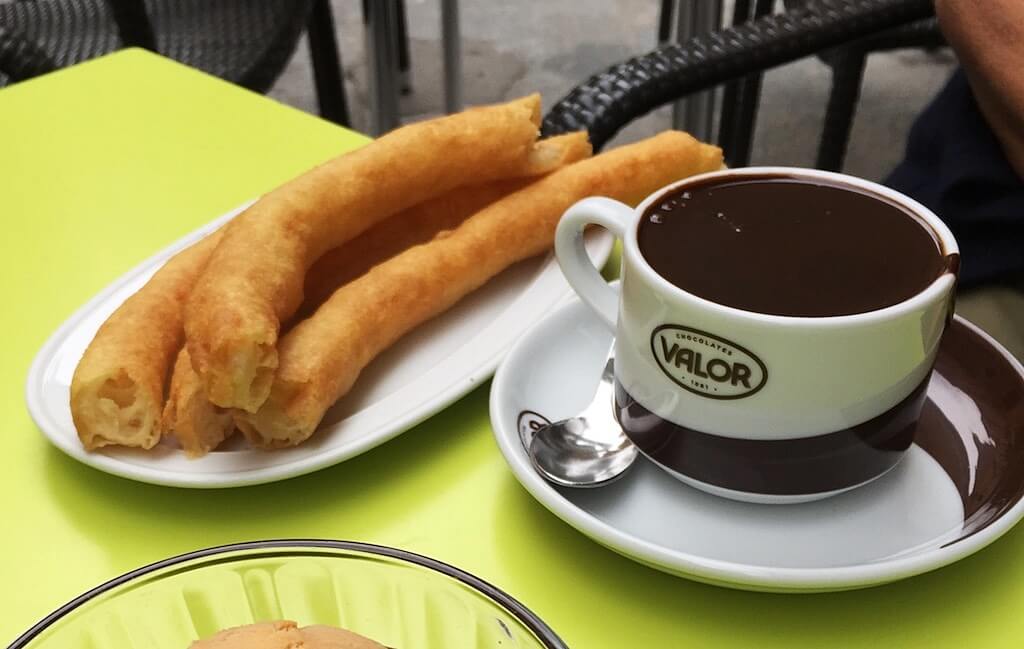
Madrid is a great destination in which to try this delicious combination, and the absolute best place is Chocolateria San Gines, the oldest chocolateria in Madrid.
Just off Calle Mayor in the centre of the city and close to many of the top attractions, San Gines is passionate about getting the exact thickness of the chocolate just right and ensuring the churros are fluffy inside and crispy outside.
For around €4.50 you can enjoy a cup of chocolate and six churros, a perfect way to start a busy day’s sightseeing in Spain’s fabulous capital city.
Best place to stay near the chocolateria in Madrid: Aspasios Calle Mayor Apartments.
Contributed by Izzy & Phil from The Gap Decaders
Visit The Hanging Houses Of Cuenca
Looking for cities in Spain with amazing landscapes, great history, and attention to cultural spots? Then visiting the UNESCO World Heritage city of Cuenca has to be on your Spanish bucket list!
Located in the middle of Spain, Cuenca is just an hour’s drive from the capital city of Madrid. The ancient city, funded by the Muslims that conquered the area, was built up rather beautifully by the Christians after taking back the land.
Cuenca is well known in Spain not only because of it’s ancient religious history, but also for it’s amazing natural beauty. It is a city strategically built on the rocks, overlooking the beautiful Huecar River gorge.
Some of the unique things to do in Cuenca include visiting the Gothic Cathedral with the golden pipe organs, the Saint Paul Bridge, the Hanging Houses, the Plaza Mayor, and the ancient walls.
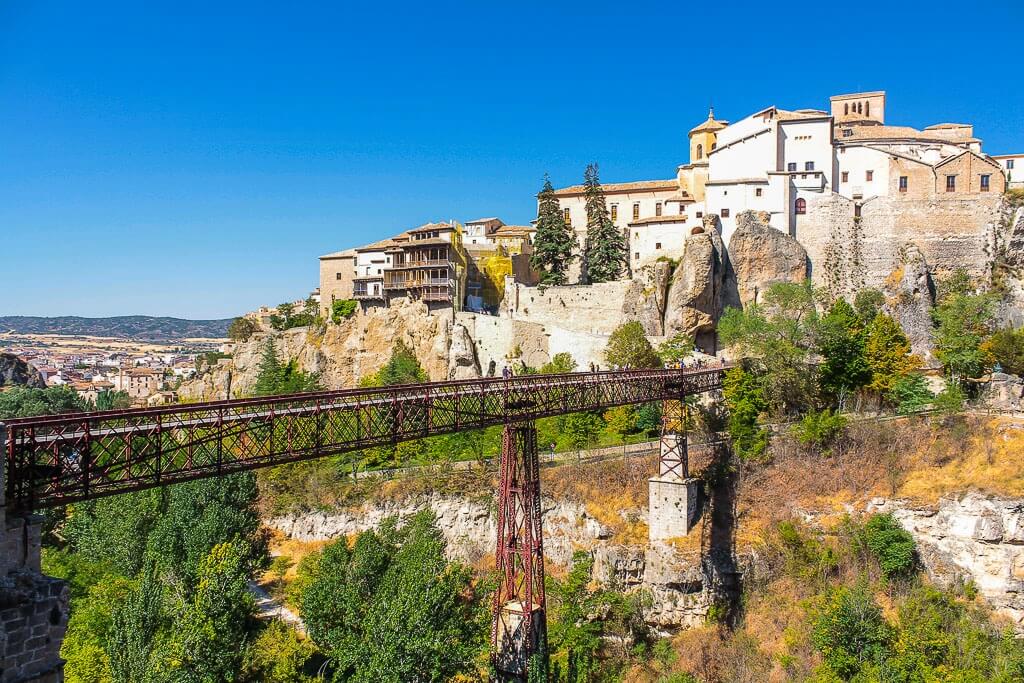
Out of these, one of the most important places to visit in Cuenca is the Hanging Houses, also called “Las Casas Colgadas” in Spanish. Even though most of them are currently inhabited, some can still be visited and seen from the inside.
The interior architecture is minimalist, charming, and very simple. There is also a Michelin two-star restaurant inside one of the houses, with a stunning view of the valley.
Another amazing point from where you can enjoy a view of the Las Casas Colgadas is the nearest bridge ie. Saint Paul bridge. The Saint Paul Bridge, also called “San Pablo” bridge, is a red iron and wood structure connecting the Religious Monastery of Saint Paul and the ancient city, crossing the river bed of Huecar.
The city still carries the elegance from the past, with some narrow cute streets that make it unique. Cuenca is a non-touristy destination in Spain that you have to include in your Spain itinerary. You’ll surely fall in love with the city, the inhabitants, and the views.
Best place to stay in Cuenca: Hotel Posada San José.
Contributed by Alessia & Toti from Italian Trip Abroad
Explore The Mérida City In Extremadura Region
If you’re interested in Roman history and wish to avoid touristy places, then Mérida has to be in your Spain bucket list. Mérida, the Mini-Rome in Spain, is a 4-hour ride from Madrid by car, train, or bus.
It was a Roman provincial capital nearly 2,000 years ago and is currently home to many Roman relics, notably the well-preserved Roman Amphitheater and Roman Theater.
The Temple of Diana is a beautiful example of Roman architecture. A Roman bridge, still in use, bears out the excellence of Roman engineering, as does the Aqueduct of Miracles, built to bring water to the city from the Proserpina Dam, also functional today.
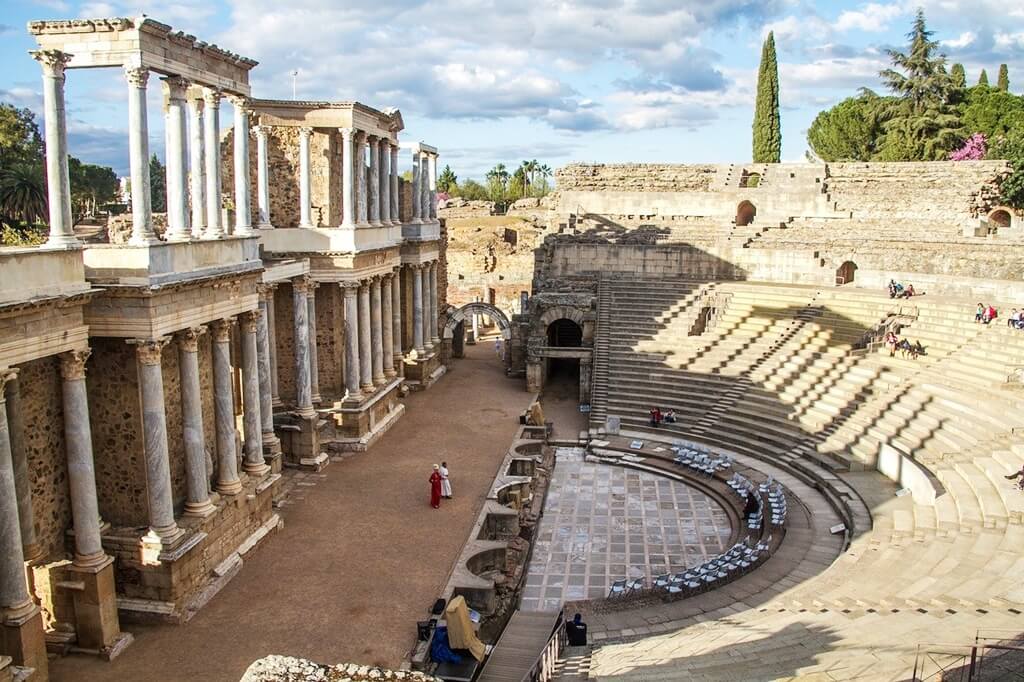
The La Casa del Mitreo, an amazing museum built around a 2nd century Roman house, gives an insight into Roman lifestyle and art. Most of these wonders are located close to one another, so you can explore them easily on foot.
Many restaurants in Mérida serve authentic Spanish cuisine. El Trasiego is great for contemporary Spanish, Mercado Gastronomico San Albin is perfect for Tapas lovers and Shangri-La El Vegetariano is good for vegetarians.
One tip – As Mérida does not have many English speakers, a translator App can be helpful in communicating and getting around the city.
Best place to stay in Mérida: Hotel Ilunion Mérida Palace.
Contributed by Jan from Leisurely Drives
Visit The Alhambra In Granada
Alhambra is not only the most famous monument in Spain, but also the most visited. Therefore, including it in your Spanish bucket list is a no-brainer. Located in the beautiful city of Granada, the Alhambra has a long and tumultuous history.
Built in 889 AD as a small Roman fortification on the ruins of another fortification, the Alhambra has seen it’s glory days starting from the 13th century, during the Moorish occupation. Often, the Alhambra was described as “a pearl set in emeralds” by the time’s poets.
Unfortunately, centuries passed and the Alhambra was left in despair. Only after Irvin Washington wrote about it in his book “Tales of the Alhambra”, the monument was renovated and brought back on the touristic map.
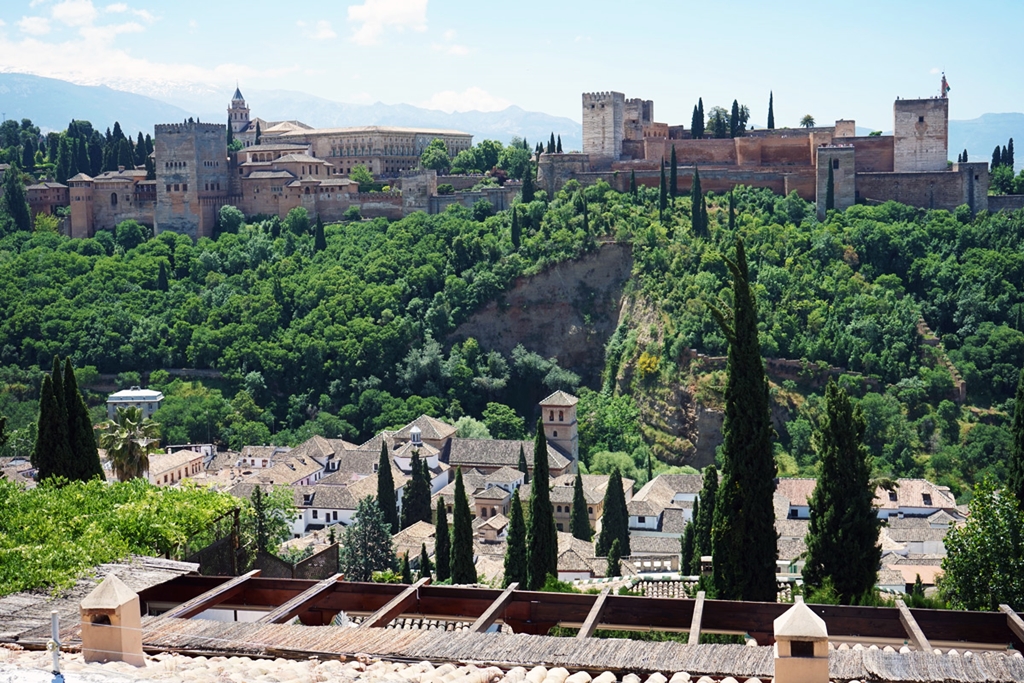
You can’t visit the city of Granada without adding the Alhambra to your Granada itinerary. The tickets to see the Alhambra are sold six months in advance, but that is just for the palace, the grounds are free to visit.
It is worth mentioning Generalife as well, the summer palace connected to the Alhambra, for its stunning gardens. If you want to experience a memorable stay in Granada, then check out accommodation options located near Alhambra, offering spectacular views over the city.
Best place to stay in Granada (near Alhambra): Hotel Alhambra Palace.
Contributed by Joanna from The World In My Pocket
Admire The Architecture Of Mezquita-Catedral De Córdoba
For culture and history lovers, the Mezquita-Catedral de Córdoba is a must-visit in Spain. It’s located in Córdoba, a charming village in the Andalusia region of Spain.
Built in 784 AD, the monument is one of the oldest standing structures from Moorish rule, the time period spanning from the 8th to 15th century where Muslims from North Africa governed over the Iberian peninsula.
After King Ferdinand III led the Spain Reconquista of Córdoba in 1236, the Mosque was converted into a Catholic Church. Rather than deconstruct the Mosque, the Spanish left many of the Islamic structures still in place.
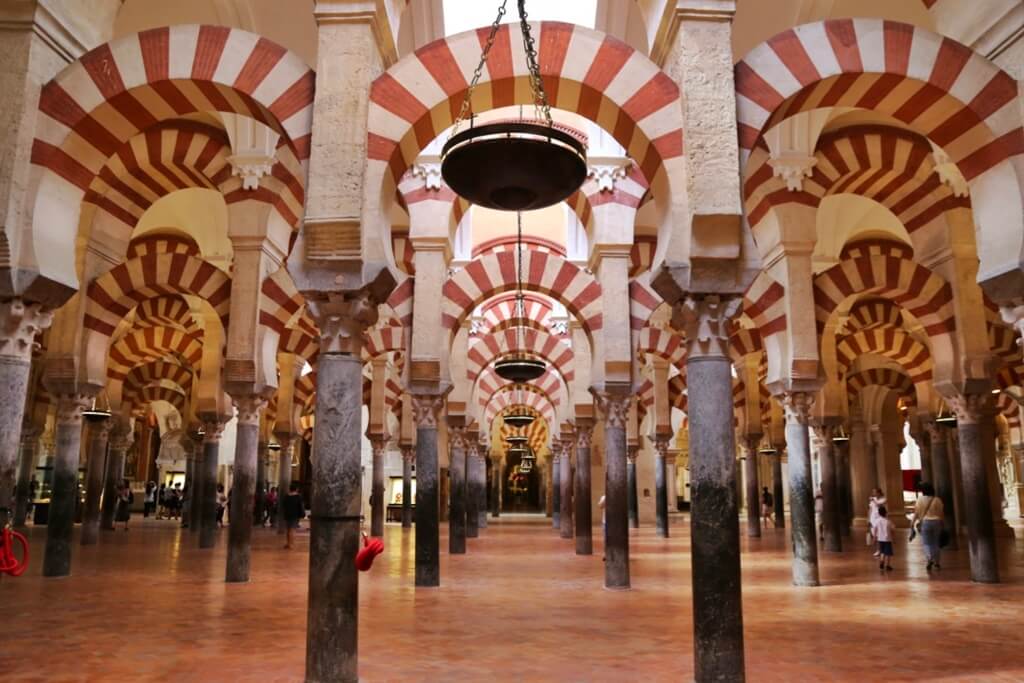
They added chapels, a bell tower, and a cathedral nave in the center of the Mosque-Cathedral. Nowadays, it stands as a fascinating mix of Islamic and Catholic architecture in a single building, one of the only places of it’s kind in the entire world.
Because you get to experience the magical amalgamation of Islamic and Catholic culture at the same place, the Mezquita-Catedral De Córdoba is an attraction that has to be included in your Spanish bucket list.
One Tip – Arrive between 8:30-9:30 a.m. for free entrance to the Mezquita. The normal ticket price is €11, with discounted prices for students, senior citizens, and children.
Best place to stay in Córdoba (near Mezquita): Hotel Hospes Palacio del Bailio.
Contributed by Allison from Alli Round The World
Walk The Caminito Del Rey In Malaga
Located in the province of Malaga, Caminito del Rey was once considered one of the deadliest paths to walk. It is very famous as it has a steep drop, not for those with a fear of heights. Thus, walking the Caminito del Rey is one of the most thrilling experiences in Spain.
Caminito del Rey derives it’s name from Camino del Rey which means “King’s little walkway”. People from all around the world come to walk the Caminito del Rey within the gorge of El Chorro.
Today, the path is well-built and made safe for tourists. However, before the revamp, a few people, unfortunately, died because of the dangerous and unsafe path.
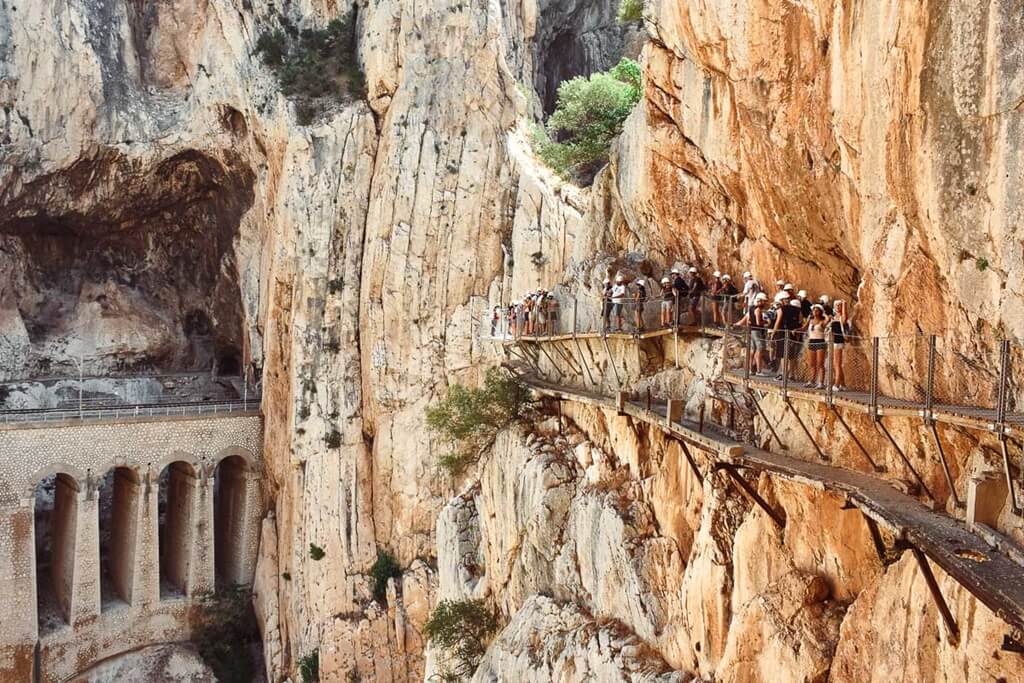
It is a beautiful walk as you have picturesque views of the valleys, mountains, and reservoirs. The sheer thrill of sauntering along a walkway that’s hanging over 100 metres up on a cliff-face makes the experience a worthy Spain bucket list item.
It is only a train ride away from the lovely city of Malaga, which makes it very convenient for a day trip. If you’re planning to stay, then an ideal place would be one that’s close to the centre of Malaga, having easy access to the train station.
Best place to stay near Caminito del Rey (in Malaga): Apartamentos Océanos.
Contributed by Kerrie & Woody from Just Go Travelling
Sleep And Dine In The Royal Monastery Of Guadalupe
There’s a good chance you’ve heard of “Our Lady of Guadalupe” before but have no idea where Guadalupe is. Many people assume it’s in Mexico since there is a huge basilica devoted to Our Lady of Guadalupe in Mexico City.
But the original image of Our Lady of Guadalupe is in the remote Extremadura region of Spain; it was the Spanish conquistadores who brought their devotion to this incarnation of Mary with them to the New World.
Christopher Columbus also named what is now the French overseas territory of Guadeloupe after this version of Mary.
For several hundred years, the Royal Monastery of Guadalupe was the most important monastery in all of Spain. It was an official royal sanctuary where the King and Queen worshipped.
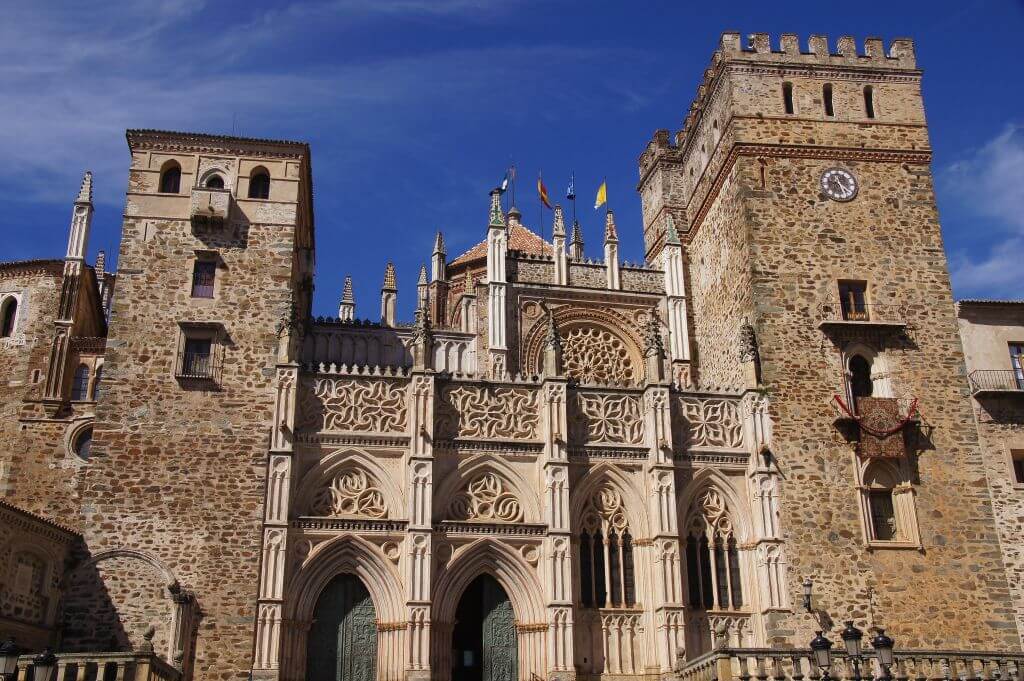
Still a popular place of pilgrimage for devotees in Spain, it remains very much off the beaten track for foreign visitors. This is still an active monastery and the monks who live here even run a guesthouse and a restaurant inside the monastery complex.
Dining in the romantically lit courtyard is an unforgettable experience. After your meal, you can head straight up to your room in the hospedería. Rooms are comfortable if not luxurious and offer very good value.
The priceless experience of dining and sleeping inside a famous place of pilgrimage makes the Royal Monastery of Guadalupe a must-include in your Spain bucket list.
Best place to stay is a hotel inside the monastery: Hospederia del Real Monasterio.
Contributed by Wendy Werneth of The Nomadic Vegan
Tour The Coastal Town Of Conil De La Frontera
Conil de la Frontera is a lovely, coastal town in the province of Cadiz where not many foreigners make it. Yet it’s a popular holiday spot among the Spanish, especially people from Seville who flock here in the summer months of July and August.
Conil de la Frontera is the perfect place to experience a beach town like a local. It’s exclusivity makes it a Spanish bucket list destination, worthy of inclusion in an ideal Spain itinerary. There are plenty of things to do in Conil, as it’s known by locals.
The town has some of the best beaches in southern Spain like La Fontanilla beach and Calas de Roche beach. The former is closed up by tall cliffs while the latter is a mesmerizing cove beach. In both their cases, you can only get down to the actual beach by maneuvering a steep set of stairs.
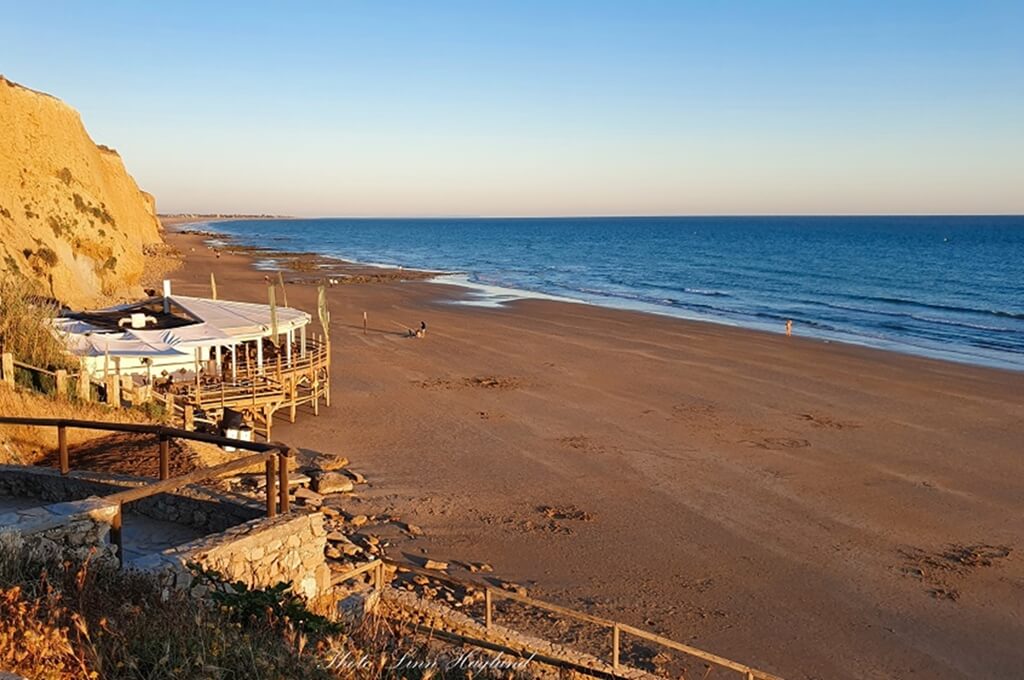
In the village, make sure you stroll along the quaint streets, visit Torre de Guzmán, Convento de la Victoria, and the Church of Catalina. Learn about the history of the fishing village at Raice Conileñas Museum and get the best views of the coastline from Mirador del Jabiguero.
To enjoy a good meal, head to La Fabrica Conil or Misura. And for the best ice cream, go to Heladeria Artesan The Marsalao.
Best place to stay in Conil de la Frontera: Hostal Santa Catalina.
Contributed by Linn Haglund of Brainy Backpackers
Take a Day Trip To Tabarca
Just off the coast of Alicante is the tiny island of Tabarca, an attractive Spanish bucket list destination that’s pristine and feels like a step back in time. To get to the island, you have to take a ferry from Alicante port.
Try buying the tickets of the boat to the island in the morning so you have enough time to spend on the island. You can also get a boat from Torrevieja marina.
Expect to pay €14-20 for a return ticket. Many of the boats have glass bottoms so you can see the marine life as you cross the water. Make sure to look through the glass bottom when you arrive at the small port in Tabarca as the reef underneath is full of life.
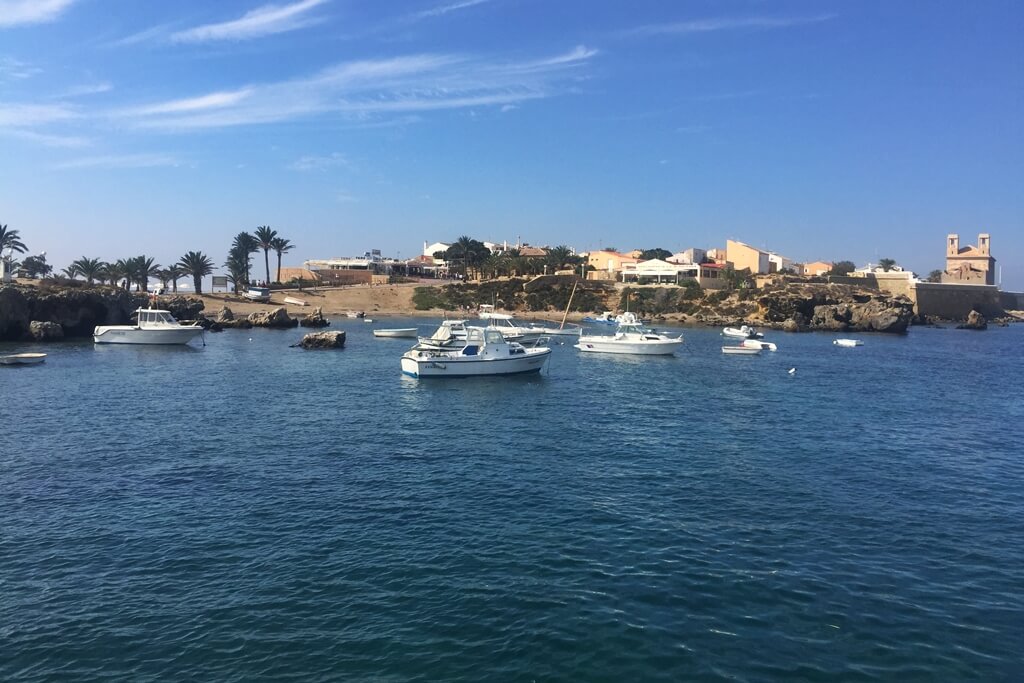
The island majorly consists of a tiny marine and nature reserve and an old Venetian fort. Half the island is protected land full of birds, while the other half is a small village behind the walls of the old fort. Inside, you will find cute shops, tiny restaurants, and musicians in the square.
Tabarca is tiny but full of life and transports you to another world. Stop at any of the restaurants for huge tasty pans of paella. Accommodation is limited on the island so try booking it in advance to be on the safer side.
Best place to stay in Tabarca: Boutique Isla Tabarca.
Contributed by Natalie from Natalie-Collins.com
Do The Seville Cathedral Rooftop Tour
If you’re planning a trip to Seville, then taking a rooftop tour of Seville Cathedral is a Spain bucket list activity that cannot be missed. The cathedral is the world’s largest Gothic church and the third-largest church anywhere in the world.
On a rooftop tour of Seville Cathedral, you’ll get to take secret staircases up to the roof, accompanied by a guide who tells you the cathedral’s secrets – how it was constructed, how to spot its origins as a mosque and why one end of the cathedral is built in a completely different style.
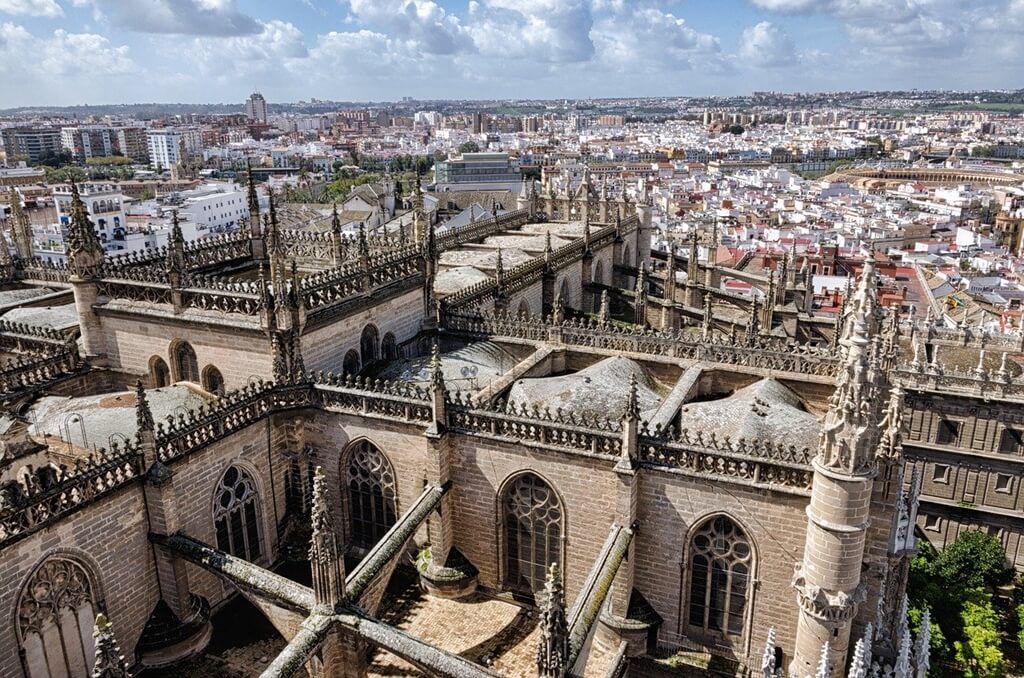
The rooftop tour is absolutely fascinating, and the views over the Real Alcazar gardens next door and the Seville skyline are stunning.
Tickets for the rooftop tour can be bought online at the cathedral’s website and cost €16. Places are limited so it’s best to book well in advance.
Best place to stay in Seville (near the Cathedral): Hotel Casa Del Poeta.
Contributed by Helen from Helen on her Holidays
Visit The Prado Museum In Madrid
One of the things that you must include in your Spain bucket list is visiting the Museo Nacional del Prado in Madrid.
The museum is housed in an architecturally stunning building that was built in 1785. It was first opened to the public in November 1819. The building is considered a monument in Spain.
The Prado Museum, located at Calle de Ruiz de Alarcón, is possibly one of the best and most visited museums in the world, for it’s extensive collection of masterpieces of precious Spanish and European art.
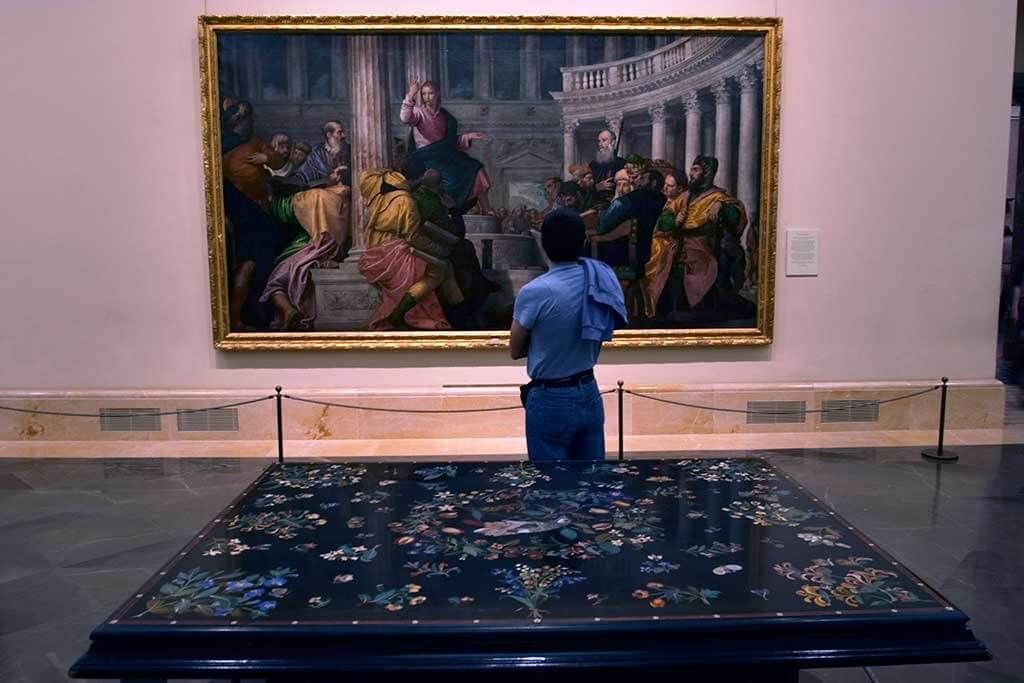
The most famous painting of the museum is “Las Meninas” (The Maids of Honour) painted by Diego Velázquez, who was a renowned Spanish artist. Other highlights are Goya’s Black Paintings, which he painted directly onto his walls just before his death, and Bosch’s Garden of Earthly Delights.
Prado has the best collection of Flemish art in the world. This is because Belgium and the Netherlands were once part of the Spanish Hapsburg Empire. Fans of Rubens, Hieronymus Bosch and Rembrandt will not want to miss visiting this museum.
Best place to stay near the Prado Museum in Madrid: Hotel Paseo del Arte.
Contributed by Christina from Travel2next
Enjoy The Relaxed Vibe Of Mataró Town
Mataró is a highly-underrated gem just north of Barcelona that should be on your Spanish bucket list! The town of Mataró is located right on the coast and offers beaches that are just as beautiful as those in Barcelona, but way less busy.
Visit the Port of Mataró for one of the best beaches and promenades in the area. Right next to the port is a long promenade filled with restaurants, cafes, and shops.
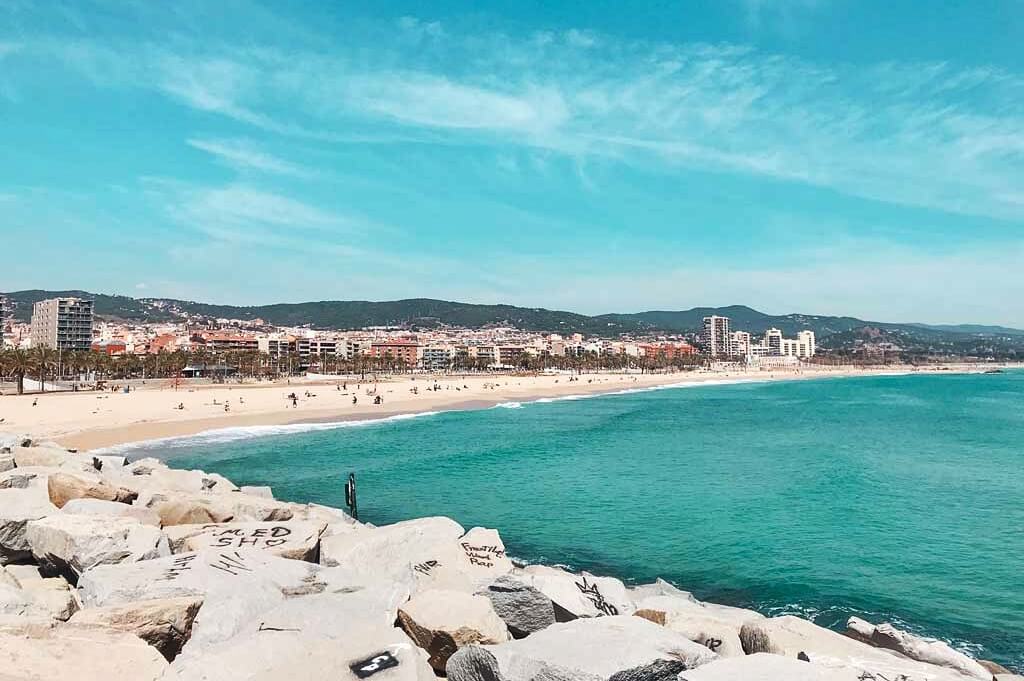
One of the absolute must-dos in Mataró is eating the churros at Xurreria Rosita, an amazing churros con chocolate cafe. They serve up a wide variety of churros and every item on their menu is super affordable. Plus, it’s only a short walk away from the Port of Mataró.
Looking for an affordable place to stay in Mataró? Consider staying at a luxurious yet budget-friendly accommodation that offers gorgeous views of the Mataró beach, and is close to Barcelona’s city centre!
Best place to stay in Mataró: Hotel Ibis Barcelona Mataro.
Contributed by Krystianna from Volumes & Voyages
Explore The City Of Segovia
One of the prettiest and most charming places to visit in Spain is the UNESCO Heritage-listed city of Segovia. The ancient city, located about 100 km north of Madrid, makes for a great day trip from the nation’s capital going by car or train.
There’s plenty to see in Segovia, although the pinnacle is the iconic El Aqueducto or the Aqueduct of Segovia. This is also the symbol of the city, with images of the aqueduct featuring on street signs and even the drain covers!
There are two fascinating facts about the aqueduct that make it a Spanish bucket list worthy attraction. Firstly, the 160 arches of the aqueduct are still held together by gravity. And secondly, the aqueduct, even after hundreds of years, still works and delivers fresh water to the city to this day.
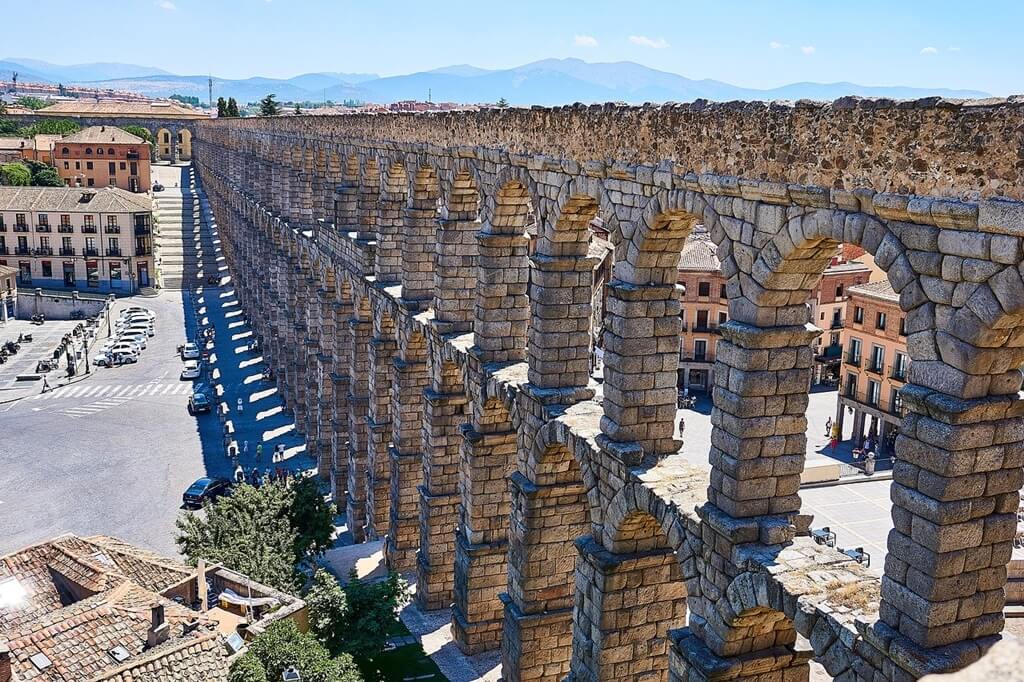
Like lots of Roman structures, there are several interesting stories associated with the aqueduct as well. Stories as to who built it and how it got there.
Stories ranging from the Roman god Hercules finding it to the Devil building it to impress a girl. Although the stories are entertaining, in actual fact, the aqueduct was built by the Romans in the 1st Century AD.
Two other ‘can’t miss’ attractions in Segovia are – the Alcazar of Segovia which looks just like Disney’s Magic Kingdom with it’s spires and cylindrical towers and the gothic-style Segovia Cathedral which looms over the town square.
You could spend hours wandering the cobbled streets and getting lost in the magic of the city. If you get peckish, then do try tasting the sugary sweet treat – Ponche Segoviano.
Best place to stay in Segovia: Hotel Real Segovia.
Contributed by Becki from Meet Me In Departures
Witness The Magic Fountain Of Montjuic in Barcelona
One of the most unique and free things to do in Barcelona at night is witnessing the Magic Fountain show at Montjuic, a tall impressive mountain in the heart of the city. The fountain is situated in the Montjuïc neighborhood of Barcelona, near the Plaça d’Espanya.
Find yourself a seat fronting the Museu Nacional d’Art de Catalunya, with impressive views of Barcelona from above and enchanting views of the fountains below.
Catching the sunset early, just before the start of the show is a wonderful prelude to the experience and when it’s finally dark, the fountains start to enthrall you with a scintillating display of light, motion, colour, and music.
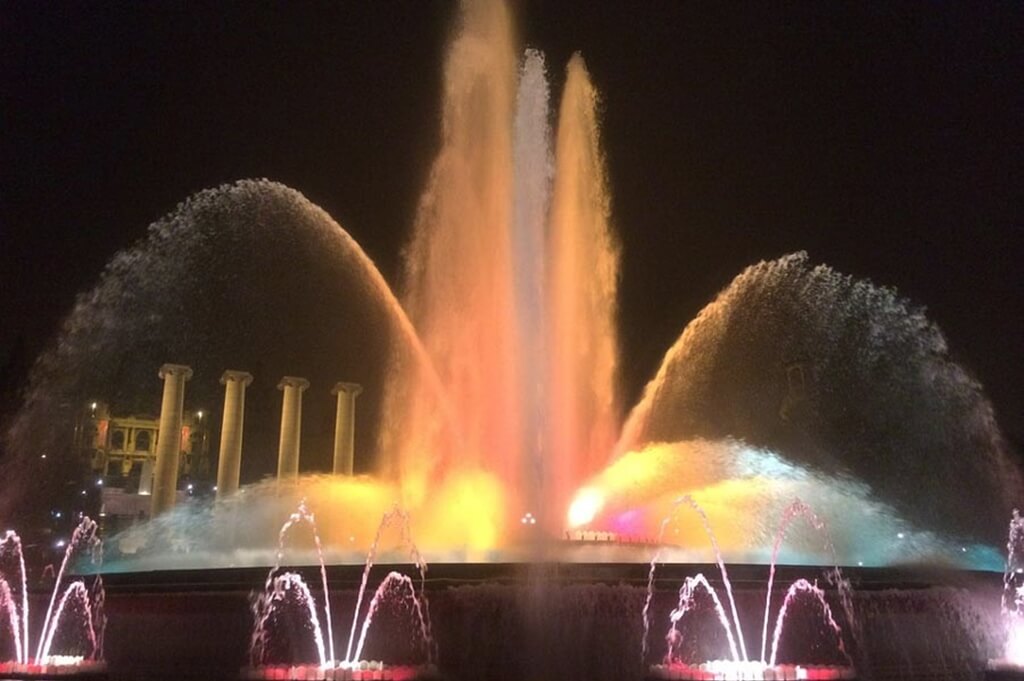
The sight of the water jet streams dancing in sync with the light, to the beats of classic and contemporary music, leaves you spellbound.
The best part about this fantastic 20-minute show is that it is free for all. Thus, it is both – a wonderful and inexpensive Spain bucket list activity that needs to be included in your Spain itinerary.
Best place to stay near Montjuic in Barcelona: Hotel Concordia Barcelona.
Contributed by Noel Morata from Travel Photo Discovery
Relish The Delicious Foods Of Seville
Seville has been host to a number of influential cultural groups throughout the centuries including the Moors and Gypsies who had a significant impact on the cultural and culinary underpinnings of the city.
From the sweet to the savory to the unusual – Seville will surely offer you some of the best food experiences in Spain. And this is why, relishing the delicious foods of Seville is a worthy Spanish bucket list activity.
Start your day at “El Comercio” for a sweet breakfast of fluffy churros to be dipped in either thick hot chocolate or coffee and sugar. Next, head over to “Alvaro Peregil”, one of the tiniest watering holes in the world for a glass of the famed ‘Vino de Naranja’ or Orange wine.
Use caution and finish one glass before you order another – Vino de Naranja packs a punch. Don’t forget to admire the animal head hanging on the wall and the sign forbidding gypsies from singing in the establishment.

Feeling brave from drink? This is the perfect time to try an oxtail or a pork cheek – both Sevillano delicacies and can be found in many places. Pork cheek has a short rib texture, and if you’re nervous about oxtail – it can be ordered in croquette form.
With the sun high in the sky and the heat settling in, grab a bowl of gazpacho or salmorejo from anywhere in the city. Both are chilled soups with a tomato base, perfect for consuming on a hot day!
In the evening, grab a cup of any of the unique gelato flavors from “Gelateria Artesana La Fiorentina” where the owner studied the art of gelato-making in Florence.
Finally, end your night with some wine, queso, and jamon at “Patio San Eloy”, a bar where you can sit on the blue, tiled steps and enjoy a lively and communal atmosphere.
Best place to stay in Seville to do the Seville food tour: Hotel Vincci La Rabida.
Contributed by Stephanie Ambarsumyan from Wandering Why Traveler
Experience Horse Riding In El Rocío
Nestled up against the Doñana National Park, in the Huelva Province of Andalusia, is the peculiar town of El Rocío. Resembling something close to a movie set, it is Spain’s very own taste of an imagined Wild West.
Horses plod through the sandy streets of the town centre, more at home on this surface than cars, while their riders call at local cafes, consuming their drinks while remaining on their horses. El Rocío truly is one of a kind.
When in town, take a horse riding trip to the neighbouring Doñana National Park; a large, sandy woodland, famous for its population of wild deer.
Rutas Doñana offers guided horseback tours, as well as carriage rides for those not wanting to get into the saddle.
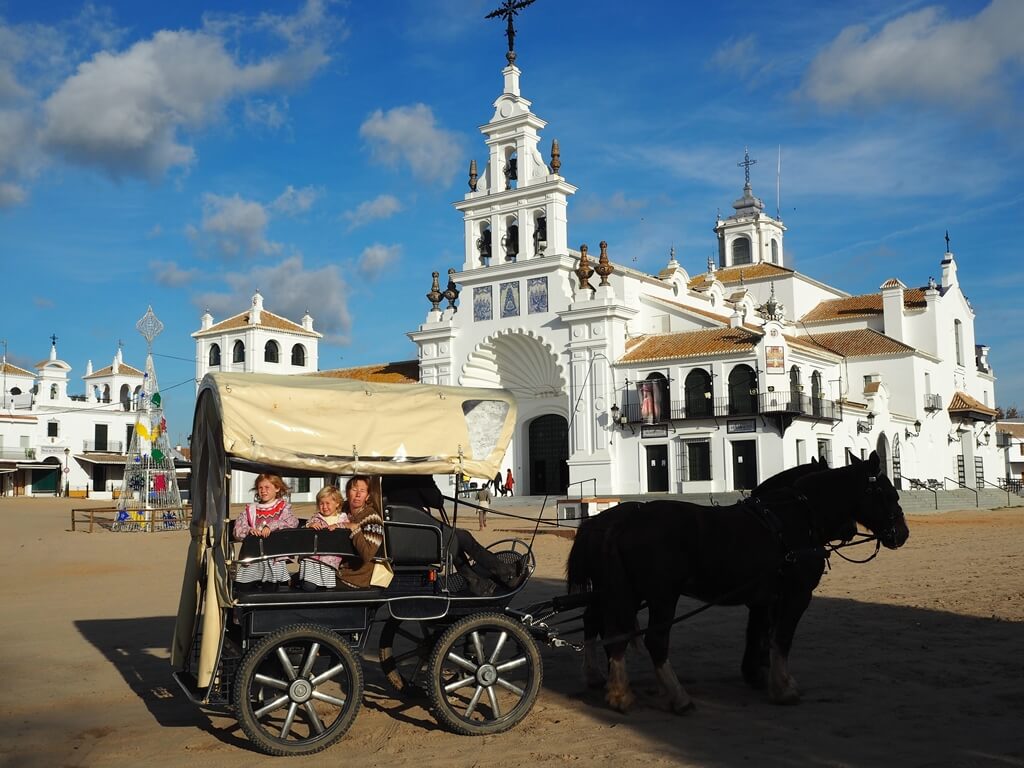
Exploring El Rocío and Doñana on a horseback is one of the most unique experiences in Spain and an activity that has to be included in your Spain bucket list.
The town centres around the Hermitage Church of El Rocío, which is home to the Virgin of El Rocío; a much revered carved wooden statue of the Virgin Mary from the 14th century, attracting close to a million pilgrims each year.
There are many restaurants to choose from, with Mesón “La Madre” serving up tasty local tapas dishes.
Year-round sunshine ensures that you won’t be disappointed visiting the town at any time. For an Andalusian winter holiday with a difference, consider combining this visit with spending Christmas in Nerja.
Best place to stay in El Rocío: Hotel La Malvasía.
Contributed by Rachel from Children of Wanderlust
Conclusion
So that was a comprehensive list of all the experiences in Spain that you need to include in your Spanish bucket list. It covers everything under the sun- nature, culture, food, history, adventure, hidden gems, and mainstream destinations.
Spain is one of the most tourist-friendly countries in the world. The locals are warm and always greet you with a smile. In a way, Spain feels like a home away from home. To conclude, all I can say is that you have to visit Spain at least once in your lifetime to see what true hospitality really is!
SHARE the post “Spanish Bucket List: 28 Best Experiences In Spain That You Cannot Miss” with your friends, family, acquaintances, and travel buddies to help them plan their Spain trip.
PIN the image below to save the post for future Spain travel planning. Also, SUBSCRIBE to The Wandering Vegetable for more such travel inspiration.
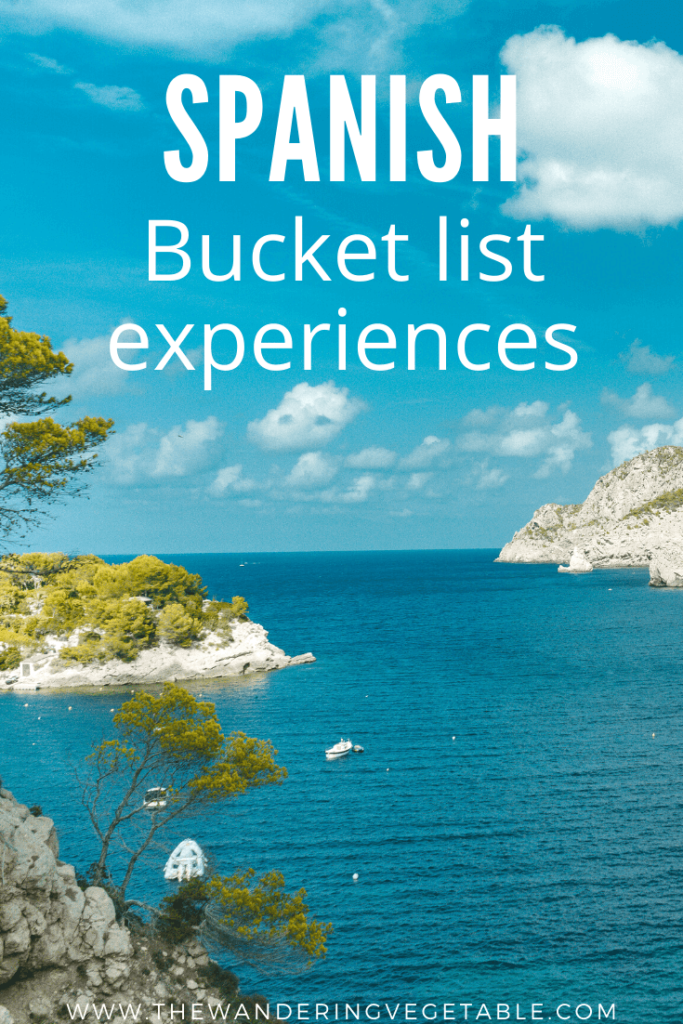
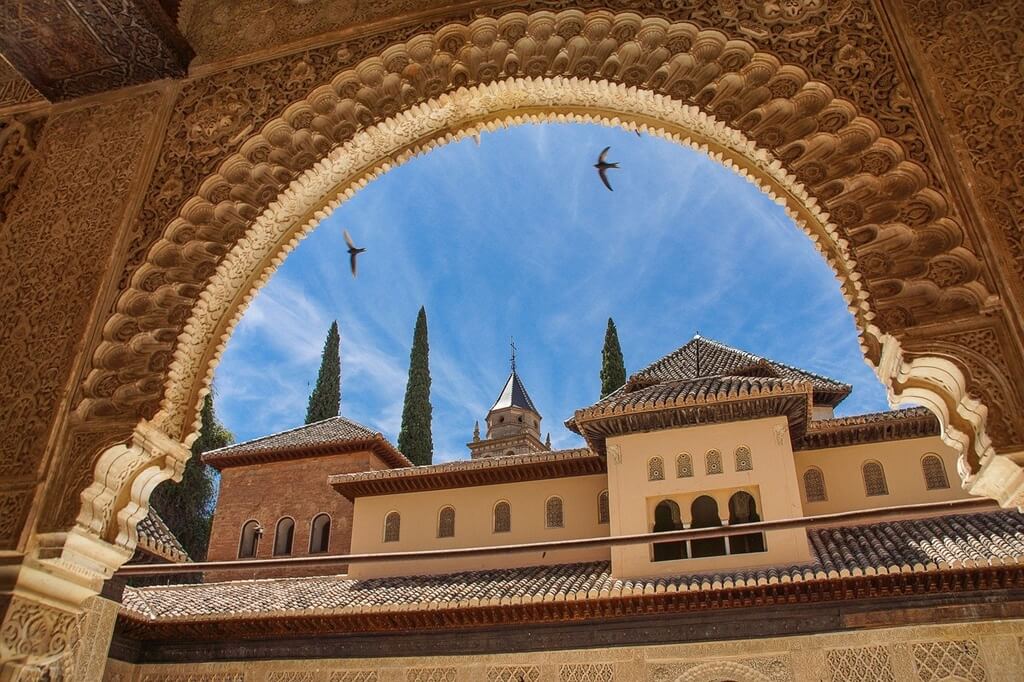
8 comments
Really amazing article. I have just finished your Turkey Itinerary and now this one, you really write comprehensive travel posts. Helps that you don’t just scratch the surface but actually provide valuable travel info that can help people like me plan their travels!
Your photos are amazing! What a buffet of experiences. This is the perfect destination for a trip post the pandemic. Reading your blog has definitely got me thinking about coming up with a plan to visit Spain in the near future.
You aptly described it Michael. It is indeed a lavish buffet of memorable experiences. Goodluck with your future ambition to explore Spain!
I traveled to Spain last year for the first time and it was mind-blowing. Why did it take me so long to go, I wonder? And now after reading this long list, I feel like another trip’s due soon hahaha
Well, good luck for your future Spanish adventures in advance Nicole.
[…] while you are in Spain, don’t forget to check out this Spanish Bucket List for 28 Best Experiences in Spain that you cannot […]
[…] flan, arroz con leche, and custard are a few of the most popular recipes. You can get a more authentic Spanish experience by browsing our extensive collection of Spanish-inspired […]
[…] can pair manchego and roncal to create an authentic Spanish experience at […]